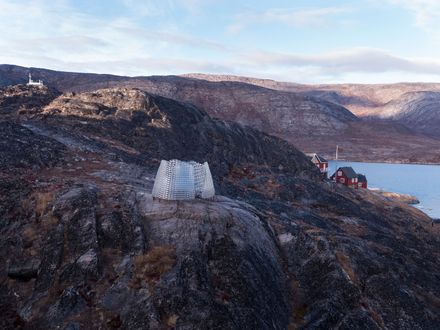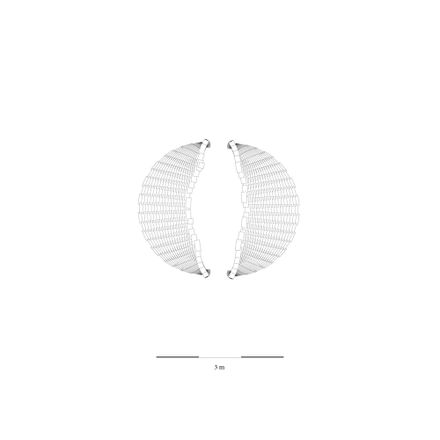Qaammat Pavilion
ARCHITECTS
Konstantin Arkitekter
CONCEPT, DESIGN, DEVELOPMENT AND CONSTRUCTION
Konstantin Ikonomidis
ADHESIVES RESEARCH
Faidra Oikonomopoulou And Telesilla Bristogianni, TU Delft Glass & Transparency Group
SITE MANAGER
UNESCO World Heritage Site, Aasivissuit – Nipisat: Paninnguaq Fleischer Lyberth
YEAR
2021
LOCATION
Sarfannguit, Greenland
CATAGORY
Pavilion
Text description provided by architects.
Located in Sarfannguit, a cultural landscape in West Greenland and a UNESCO World Heritage site since 2018, the Qaammat pavilion by Konstantin Ikonomidis is designed to celebrate and promote the Inuit intangible cultural heritage and traditional knowledge of the environment.
Characterized by the two fjords that meet on Sarfannguit’s eastern tip on the hills, the pavilion’s location has been carefully chosen by the local community, UNESCO site manager Paninnguaq Fleischer-Lyberth and the commissioned architect Konstantin Ikonomidis for its impressive view over the Sarfannguit municipality.
Set on the planned trail between Sarfannguit and Nipisat, this site-specific installation will serve as a landmark and a gathering point and dissemination site in Sarfannguit, where the World Heritage site’s beautiful surroundings can be experienced by locals and visitors to the village.
The Qaammat pavilion is designed as a poetic and aesthetic object, but most importantly as a symbolic gesture acknowledging the natural site and rich history, the distinctiveness of the Greenlandic culture, and the spiritual sensibilities rooted in Sarfannguit.
The choice for the site was guided by a strong desire to respect nature and find a balance within the extraordinary landscape. The pavilion seeks to embrace a sensitivity toward nature instilled in the local culture and establishes a subtle presence by blurring the physical boundary between man-made structures and the natural terrain and landscape.
The pavilion is anchored in the rocky terrain. Drilled into the ground with 40-mm holes, the foundation is constructed with rock anchors in the exact same way that every typical house in the settlement is.
Attached to the upper part of the metal poles is a custom-made stainless steel bracket with a circular geometry. The metal bar is fully horizontal and the poles vary in length according to the terrain. The curving walls, constructed in glass blocks, form a linear pathway open at both ends, which serves as the entrance to the pavilion.
One of the more distinctive features of the structure is its glass ‘shell’, its play of transparencies, scale, and weight, resulting in a feeling of surreality. The Qaammat pavilion can simultaneously alter the viewer’s perspective, merge, and even vanish into the surrounding topography.
The solid cast glass bricks are manufactured by WonderGlass, founded in 2013, by Christian and Maurizio Mussati. Konstantin Ikonomidis worked in collaboration with glass specialists Faidra Oikonomopoulou and Telesilla Bristogianni, TU Delft Glass & Transparency group at TU Delft University, on the technical research on the glass as a building material.
They’ve carried out experiments for the binding techniques using Dow Inc adhesive for the site-specific project and demonstrated how to perform the binding throughout a seven-day on-site workshop.
The project was initiated by Qeqqata municipality and completed with the support of Sisimiut Museum, Paninnguaq Fleischer Lyberth, Kloe Andersen, and the community of Sarfannguit, TU Delft University, and with the sponsorship of WonderGlass and Dow Inc.
The design draws inspiration from the moon and the Arctic light in combination with the snow’s reflections. An important part of the design phase was site-specific research by Konstantin Ikonomidis.
Following his earlier work and research on the subject of home, Konstantin focused on his interest in integrating landscape, culture, and human stories into the design.
Marked by encounters, conversations, and interviews with the locals, the architect’s intention is to reflect these experiences, stories, and myths poetically in the design of the pavilion.




















